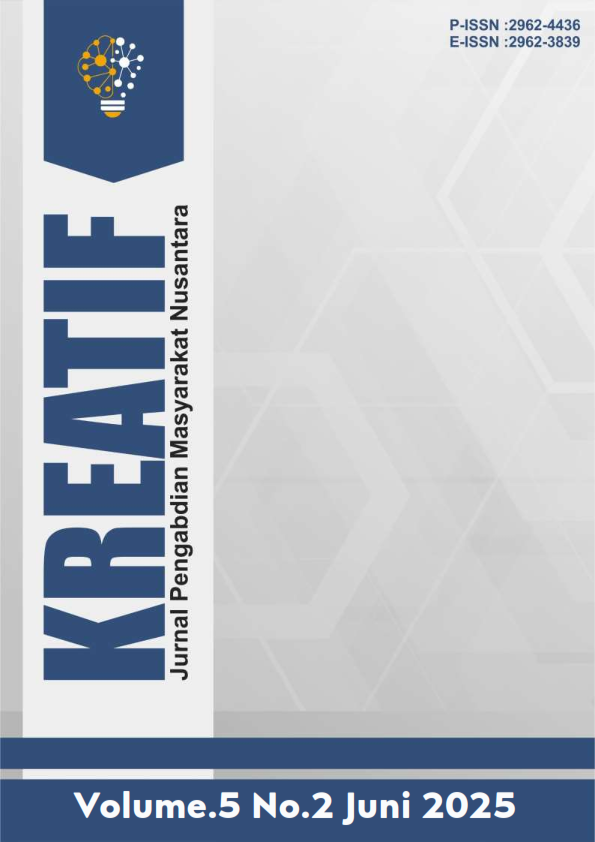Pencegahan Stunting Sejak Dini di Kabupaten Enrekang
DOI:
https://doi.org/10.55606/kreatif.v5i2.6352Keywords:
community-education, parenting-literacy, empowerment, Posyandu, stuntingAbstract
This community service program was carried out to improve parenting literacy in the prevention of stunting in Buntu Batu Subdistrict, Enrekang Regency, through a participatory, community-based approach. Referring to the theories of child development ecology, community empowerment, and health literacy, the activities included dialogical education, focus group discussions, door-to-door counseling, and the distribution of locally adapted educational leaflets. The “3T” model (Regular, Monitored, Involved) was developed as a household-based educational innovation to enhance collective awareness and behavioral change in families. Pre-test and post-test results showed a significant increase in participants' understanding of the definition, causes, and long-term impacts of stunting, as well as preventive strategies. This program demonstrates that contextual and relational educational approaches can effectively overcome socio-cultural barriers and reach vulnerable groups excluded from formal forums. These findings highlight the importance of strengthening local educational hubs such as Posyandu and PKK as agents of change. The implications of this initiative suggest that integrating local cultural approaches with community participation can build a healthy, sustainable, and community-rooted parenting ecosystem.
References
Afrida, I. (2020). Hubungan ASI Eksklusif dan Status Imunisasi dengan Kejadian Stunting di Wilayah Kerja Puskesmas Bowong Cindea Kabupaten Pangkep. Nursing Inside (Nurs Insid), 2(3), 23–29.
Amin, N. A., & Julia, M. (2014). Faktor Sosiodemografi dan Tinggi Badan Orang Tua serta Hubungannya dengan Kejadian Stunting. Jurnal Gizi dan Dietetik Indonesia, 2(1), 1–8.
Beal, T., Tumilowicz, A., Sutrisna, A., Izwardy, D., & Neufeld, L. M. (2018). A review of child stunting determinants in Indonesia. Maternal & Child Nutrition, 14(4), e12617. https://doi.org/10.1111/mcn.12617
Bronfenbrenner, U., & Morris, P. A. (2006). The bioecological model of human development. In R. M. Lerner & W. Damon (Eds.), Handbook of child psychology: Vol. 1. Theoretical models of human development (6th ed., pp. 793–828). Wiley.
Cornwall, A., & Jewkes, R. (1995). What is participatory research? Social Science & Medicine, 41(12), 1667–1676. https://doi.org/10.1016/0277-9536(95)00127-S
Habermas, J. (1984). The theory of communicative action, Vol. 1: Reason and the rationalization of society. Beacon Press.
Helm, J. L., & Spencer, J. P. (2016). Theoretical and Methodological Considerations for the Study of Timing in Human Development. Developmental Psychobiology, 58(4), 497–511. https://doi.org/10.1002/dev.21393
Keino, S., Ploubidis, G. B., & Grace, E. M. (2014). Determinants of stunting and overweight among young children and adolescents in Sub-Saharan Africa. Food and Nutrition Bulletin, 35(2), 167–178. https://doi.org/10.1177/156482651403500203
Kementerian Kesehatan RI. (2020). Profil Kesehatan Indonesia 2019. Jakarta: Kemenkes.
Nutbeam, D. (2000). Health literacy as a public health goal: A challenge for contemporary health education and communication strategies into the 21st century. Health Promotion International, 15(3), 259–267.
Papalia, D. E., Olds, S. W., & Feldman, R. D. (2008). Human development (10th ed.). McGraw-Hill.
Putnam, R. D. (2000). Bowling Alone: The collapse and revival of American community. Simon & Schuster.
Sorensen, K., Van den Broucke, S., Fullam, J., Doyle, G., Pelikan, J., Slonska, Z., & Brand, H. (2012). Health literacy and public health: A systematic review and integration of definitions and models. BMC Public Health, 12(1), 80. https://doi.org/10.1186/1471-2458-12-80
Ty Beal, et al. (2017). A review of child stunting determinants in Indonesia. Maternal & Child Nutrition, 14(4), e12617. https://doi.org/10.1111/mcn.12617
Downloads
Published
How to Cite
Issue
Section
License
Copyright (c) 2025 KREATIF: Jurnal Pengabdian Masyarakat Nusantara

This work is licensed under a Creative Commons Attribution-ShareAlike 4.0 International License.








